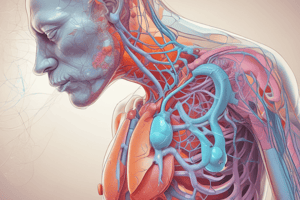Podcast
Questions and Answers
What is the process of exchange of O2 from the atmosphere with CO2 produced by the cells called?
What is the process of exchange of O2 from the atmosphere with CO2 produced by the cells called?
breathing
Which organisms primarily use gills for respiration?
Which organisms primarily use gills for respiration?
- Reptiles
- Fishes (correct)
- Amphibians
- Birds
Which respiratory mechanism do lower invertebrates like sponges and coelenterates use?
Which respiratory mechanism do lower invertebrates like sponges and coelenterates use?
- Lungs
- Gills
- Tracheal tubes
- Simple diffusion (correct)
What is the function of the organ of Corti?
What is the function of the organ of Corti?
Amphibians can respire through their moist skin.
Amphibians can respire through their moist skin.
___ is harmful and released during catabolic reactions.
___ is harmful and released during catabolic reactions.
What are the respiratory organs used by most aquatic arthropods?
What are the respiratory organs used by most aquatic arthropods?
Which group of animals has mechanisms of breathing that vary based on their habitats?
Which group of animals has mechanisms of breathing that vary based on their habitats?
Flashcards are hidden until you start studying
Study Notes
Human Physiology Overview
- Reductionist approach increased the use of physico-chemical concepts and techniques in studying life forms.
- Majority of studies involved surviving tissue models or cell-free systems, leading to advancements in molecular biology.
- Molecular physiology is closely related to biochemistry and biophysics.
- Systems biology highlights that biological processes arise from interactions within biological systems rather than purely molecular or organismic perspectives.
- Emergent properties result from interactions across various levels, from molecules to communities.
Breathing and Gas Exchange (Chapter 14)
- Oxygen (O2) is essential for energy production through the breakdown of macromolecules such as glucose and fatty acids.
- Carbon dioxide (CO2) is a byproduct that must be released to maintain cellular homeostasis.
- Breathing is the exchange of O2 and CO2, crucial for sustaining life functions.
- Breathing mechanisms vary by species and are adapted to habitats and levels of biological organization.
Respiratory Organs
- Lower invertebrates (e.g., sponges, flatworms) exchange gases through simple diffusion across their body surfaces.
- Earthworms utilize a moist cuticle for gas exchange; insects employ a tracheal system to transport air internally.
- Aquatic organisms such as arthropods and molluscs rely on gills for branchial respiration.
- Terrestrial forms, including amphibians, reptiles, birds, and mammals, use lungs for pulmonary respiration.
- Amphibians can also respire through their skin, known as cutaneous respiration.
Key Figures in Anatomy
- Alfonso Corti (1822 - 1888) made significant contributions to the understanding of the cardiovascular system and auditory system in mammals.
- His most noted work includes the description of the organ of Corti, vital for converting sound vibrations into nerve impulses.
Studying That Suits You
Use AI to generate personalized quizzes and flashcards to suit your learning preferences.




